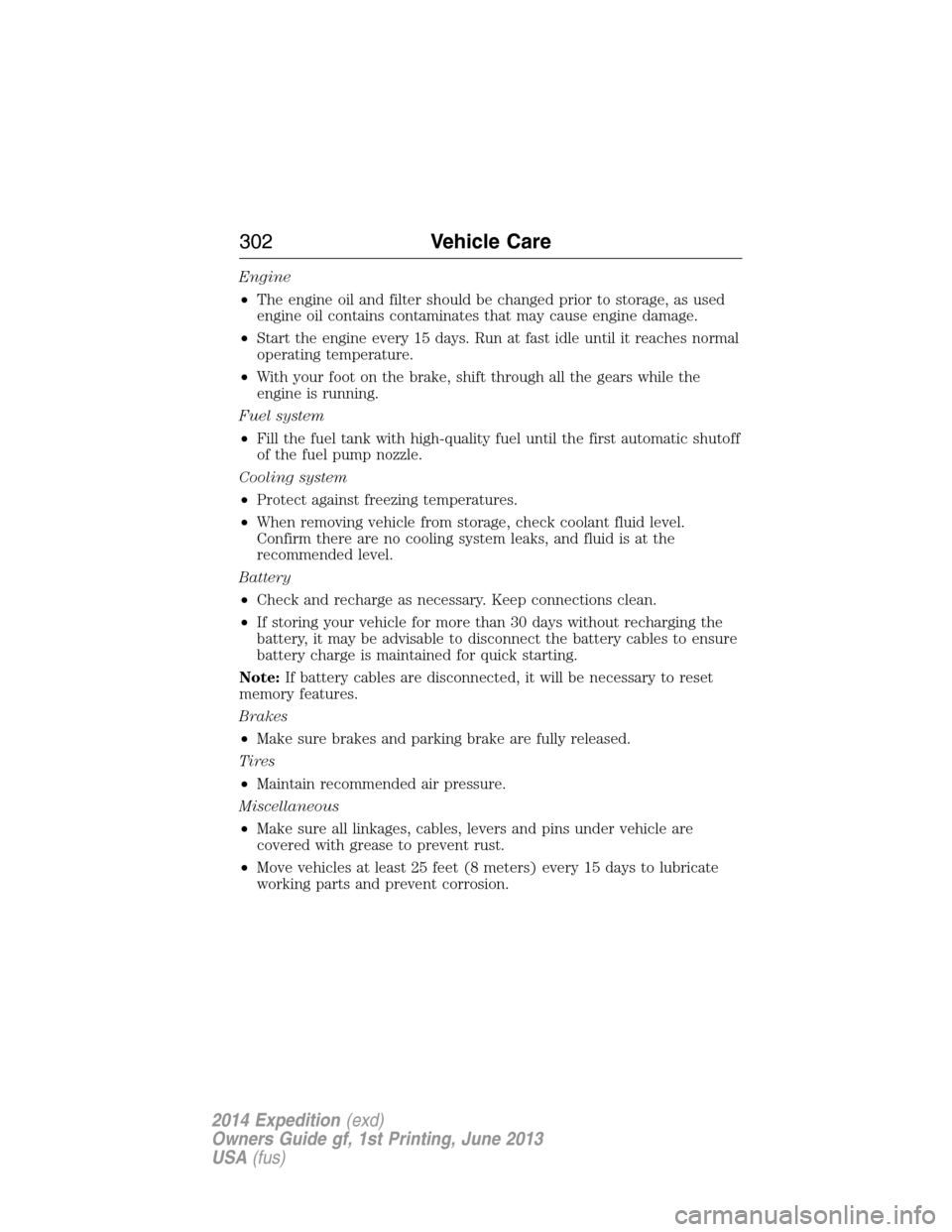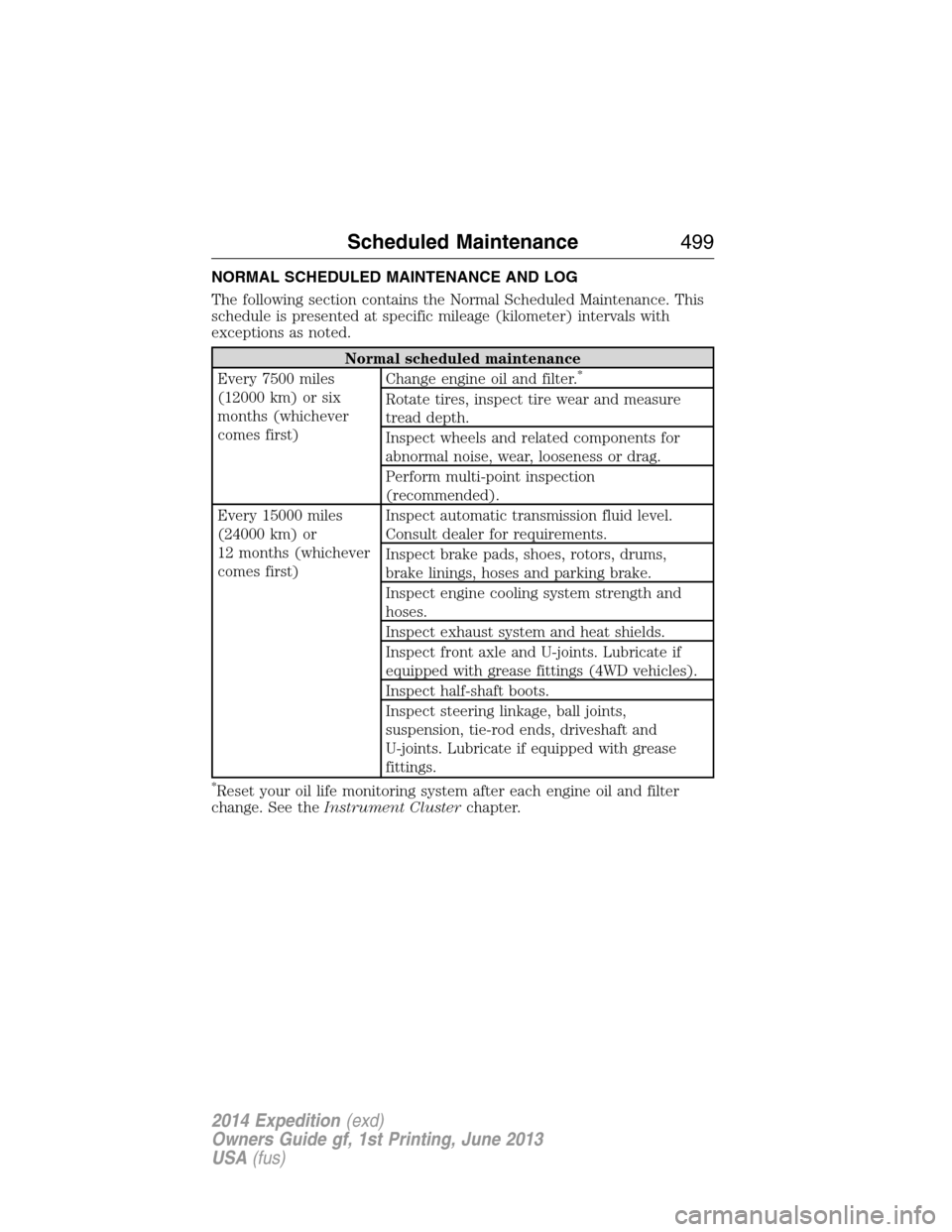Page 303 of 519

Engine
•The engine oil and filter should be changed prior to storage, as used
engine oil contains contaminates that may cause engine damage.
•Start the engine every 15 days. Run at fast idle until it reaches normal
operating temperature.
•With your foot on the brake, shift through all the gears while the
engine is running.
Fuel system
•Fill the fuel tank with high-quality fuel until the first automatic shutoff
of the fuel pump nozzle.
Cooling system
•Protect against freezing temperatures.
•When removing vehicle from storage, check coolant fluid level.
Confirm there are no cooling system leaks, and fluid is at the
recommended level.
Battery
•Check and recharge as necessary. Keep connections clean.
•If storing your vehicle for more than 30 days without recharging the
battery, it may be advisable to disconnect the battery cables to ensure
battery charge is maintained for quick starting.
Note:If battery cables are disconnected, it will be necessary to reset
memory features.
Brakes
•Make sure brakes and parking brake are fully released.
Tires
•Maintain recommended air pressure.
Miscellaneous
•Make sure all linkages, cables, levers and pins under vehicle are
covered with grease to prevent rust.
•Move vehicles at least 25 feet (8 meters) every 15 days to lubricate
working parts and prevent corrosion.
302Vehicle Care
2014 Expedition(exd)
Owners Guide gf, 1st Printing, June 2013
USA(fus)
Page 497 of 519
Owner Checks and Services
Certain basic maintenance checks and inspections should be performed
every month or at six month intervals.
Check every month
Engine oil level.
Function of all interior and exterior lights.
Tires (including spare) for wear and proper pressure.
Windshield washer fluid level.
Check every six months
Battery connections. Clean if necessary.
Body and door drain holes for obstructions. Clean if necessary.
Cooling system fluid level and coolant strength.
Door weatherstrips for wear. Lubricate if necessary.
Hinges, latches and outside locks for proper operation. Lubricate if
necessary.
Parking brake for proper operation.
Safety belts and seat latches for wear and function.
Safety warning lamps (brake, ABS, airbag, safety belt) for operation.
Washer spray and wiper operation. Clean or replace blades as
necessary.
496Scheduled Maintenance
2014 Expedition(exd)
Owners Guide gf, 1st Printing, June 2013
USA(fus)
Page 500 of 519

NORMAL SCHEDULED MAINTENANCE AND LOG
The following section contains the Normal Scheduled Maintenance. This
schedule is presented at specific mileage (kilometer) intervals with
exceptions as noted.
Normal scheduled maintenance
Every 7500 miles
(12000 km) or six
months (whichever
comes first)Change engine oil and filter.*
Rotate tires, inspect tire wear and measure
tread depth.
Inspect wheels and related components for
abnormal noise, wear, looseness or drag.
Perform multi-point inspection
(recommended).
Every 15000 miles
(24000 km) or
12 months (whichever
comes first)Inspect automatic transmission fluid level.
Consult dealer for requirements.
Inspect brake pads, shoes, rotors, drums,
brake linings, hoses and parking brake.
Inspect engine cooling system strength and
hoses.
Inspect exhaust system and heat shields.
Inspect front axle and U-joints. Lubricate if
equipped with grease fittings (4WD vehicles).
Inspect half-shaft boots.
Inspect steering linkage, ball joints,
suspension, tie-rod ends, driveshaft and
U-joints. Lubricate if equipped with grease
fittings.
*Reset your oil life monitoring system after each engine oil and filter
change. See theInstrument Clusterchapter.
Scheduled Maintenance499
2014 Expedition(exd)
Owners Guide gf, 1st Printing, June 2013
USA(fus)
Page 514 of 519

Driving under special
conditions ..................189, 195, 197
sand .........................................195
snow and ice ...........................198
through water .................196, 243
Dual automatic temperature
control (DATC) .................125, 127
DVD (if equipped) ....................362
DVD region coding ...................370
DVD system ...............................362
E
Electronic message center .......106
Electronic stability control ......204
Emergencies, roadside
jump-starting ..........................249
running out of fuel .................177
Emission control system ..........181
End user license agreement ....482
Engine ........................................336
cleaning ...................................295
coolant .....................................273
fail-safe cooling .......................276
idle speed control ...................279
lubrication specifications .......337
refill capacities ........................337
service points ..........................271
starting after a collision .........248
Engine block heater .................172
Engine oil
checking and adding ..............272
dipstick ....................................272
filter, specifications ................341
refill capacities ........................337
specifications ..........................337
Event data recording ..................12
Exhaust fumes ..........................172F
Fail safe cooling ........................276
Fleet MyKey programming ........60
Floor mats .................................244
Fluid capacities .........................337
Fog lamps ....................................89
Forward and reverse sensing
system ........................................206
Four-Wheel Drive vehicles .......190
description ..............................191
driving off road .......................193
indicator light .........................190
Fuel
cap ...........................................179
capacity ...................................337
choosing the right
fuel ...................................175–176
filler funnel .............................177
filling your vehicle
with fuel ..................................179
filter, specifications ................279
fuel pump shut-off switch .....248
octane rating ...................176, 336
quality ......................................175
running out of fuel .................177
safety information relating to
automotive fuels .....................174
Fuel - flex fuel vehicle
(FFV) .................................175–176
Fuses ..........................260–261, 265
G
Garage door opener ..........154, 158
Gas cap (see Fuel cap) ............179
Gauges .........................................99
Index513
2014 Expedition(exd)
Owners Guide gf, 1st Printing, June 2013
USA(fus)